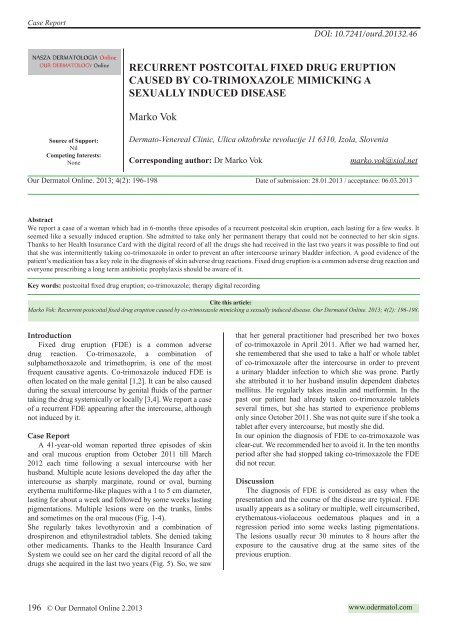download full issue - Our Dermatology Online Journal
download full issue - Our Dermatology Online Journal
download full issue - Our Dermatology Online Journal
Create successful ePaper yourself
Turn your PDF publications into a flip-book with our unique Google optimized e-Paper software.
Case Report<br />
DOI: 10.7241/ourd.20132.46<br />
RECURRENT POSTCOITAL FIXED DRUG ERUPTION<br />
CAUSED BY CO-TRIMOXAZOLE MIMICKING A<br />
SEXUALLY INDUCED DISEASE<br />
Marko Vok<br />
Source of Support:<br />
Nil<br />
Competing Interests:<br />
None<br />
Dermato-Venereal Clinic, Ulica oktobrske revolucije 11 6310, Izola, Slovenia<br />
Corresponding author: Dr Marko Vok<br />
marko.vok@siol.net<br />
<strong>Our</strong> Dermatol <strong>Online</strong>. 2013; 4(2): 196-198 Date of submission: 28.01.2013 / acceptance: 06.03.2013<br />
Abstract<br />
We report a case of a woman which had in 6-months three episodes of a recurrent postcoital skin eruption, each lasting for a few weeks. It<br />
seemed like a sexually induced eruption. She admitted to take only her permanent therapy that could not be connected to her skin signs.<br />
Thanks to her Health Insurance Card with the digital record of all the drugs she had received in the last two years it was possible to find out<br />
that she was intermittently taking co-trimoxazole in order to prevent an after intercourse urinary bladder infection. A good evidence of the<br />
patient’s medication has a key role in the diagnosis of skin adverse drug reactions. Fixed drug eruption is a common adverse drug reaction and<br />
everyone prescribing a long term antibiotic prophylaxis should be aware of it.<br />
Key words: postcoital fixed drug eruption; co-trimoxazole; therapy digital recording<br />
Cite this article:<br />
Marko Vok: Recurrent postcoital fixed drug eruption caused by co-trimoxazole mimicking a sexually induced disease. <strong>Our</strong> Dermatol <strong>Online</strong>. 2013; 4(2): 196-198.<br />
Introduction<br />
Fixed drug eruption (FDE) is a common adverse<br />
drug reaction. Co-trimoxazole, a combination of<br />
sulphamethoxazole and trimethoprim, is one of the most<br />
frequent causative agents. Co-trimoxazole induced FDE is<br />
often located on the male genital [1,2]. It can be also caused<br />
during the sexual intercourse by genital fluids of the partner<br />
taking the drug systemically or locally [3,4]. We report a case<br />
of a recurrent FDE appearing after the intercourse, although<br />
not induced by it.<br />
Case Report<br />
A 41-year-old woman reported three episodes of skin<br />
and oral mucous eruption from October 2011 till March<br />
2012 each time following a sexual intercourse with her<br />
husband. Multiple acute lesions developed the day after the<br />
intercourse as sharply marginate, round or oval, burning<br />
erythema multiforme-like plaques with a 1 to 5 cm diameter,<br />
lasting for about a week and followed by some weeks lasting<br />
pigmentations. Multiple lesions were on the trunks, limbs<br />
and sometimes on the oral mucous (Fig. 1-4).<br />
She regularly takes levothyroxin and a combination of<br />
drospirenon and ethynilestradiol tablets. She denied taking<br />
other medicaments. Thanks to the Health Insurance Card<br />
System we could see on her card the digital record of all the<br />
drugs she acquired in the last two years (Fig. 5). So, we saw<br />
that her general practitioner had prescribed her two boxes<br />
of co-trimoxazole in April 2011. After we had warned her,<br />
she remembered that she used to take a half or whole tablet<br />
of co-trimoxazole after the intercourse in order to prevent<br />
a urinary bladder infection to which she was prone. Partly<br />
she attributed it to her husband insulin dependent diabetes<br />
mellitus. He regularly takes insulin and metformin. In the<br />
past our patient had already taken co-trimoxazole tablets<br />
several times, but she has started to experience problems<br />
only since October 2011. She was not quite sure if she took a<br />
tablet after every intercourse, but mostly she did.<br />
In our opinion the diagnosis of FDE to co-trimoxazole was<br />
clear-cut. We recommended her to avoid it. In the ten months<br />
period after she had stopped taking co-trimoxazole the FDE<br />
did not recur.<br />
Discussion<br />
The diagnosis of FDE is considered as easy when the<br />
presentation and the course of the disease are typical. FDE<br />
usually appears as a solitary or multiple, well circumscribed,<br />
erythematous-violaceous oedematous plaques and in a<br />
regression period into some weeks lasting pigmentations.<br />
The lesions usually recur 30 minutes to 8 hours after the<br />
exposure to the causative drug at the same sites of the<br />
previous eruption.<br />
196 © <strong>Our</strong> Dermatol <strong>Online</strong> 2.2013<br />
www.odermatol.com















